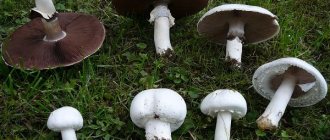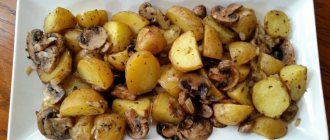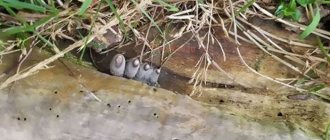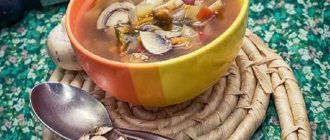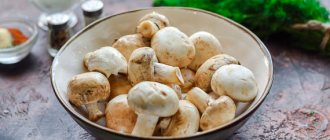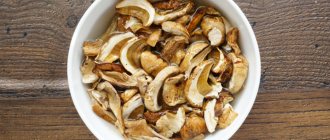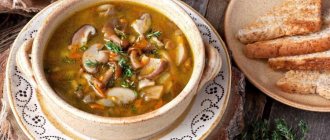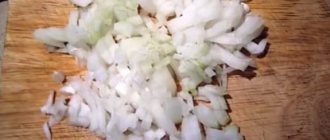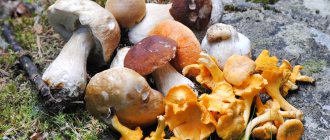Description of appearance
The classification of field champignons (Agaricus arvensis) into a separate group dates back to 1762, and even then a detailed description of this type of mushroom was formed:
- Hat. White, cream, gray or light ocher (mainly in old mushrooms), with a diameter of 7–22 cm. The shape resembles an egg or a bell, but over time it becomes almost flat, with a noticeable bump in the central part. In young plants, the edges of the cap are curled inward, while in older specimens there is a slight waviness. In dry weather, the surface of the caps cracks greatly, which is why it appears sloppy and torn. The cap is almost always smooth to the touch, and in rare cases small scaly growths become noticeable.
- Leg. Cylindrical, long (up to 12 cm high) and easily separated from the cap. Its color usually matches the color of the upper part of the mushroom, but when pressed it becomes yellowish. The lower part of the leg is usually wider and narrows towards the top. The stem of old mushrooms is empty inside, although at a young age it was solid.
- The plates on the inside of the cap can be white-gray or brownish in color with a mustard or purple tint. Old mushrooms are always dark brown or even black, with yellowish flesh inside.
- The soft part of a young field champignon is light yellow, very dense and will begin to turn yellow as soon as you cut into the mushroom.
General characteristics of champignons
It is difficult to confuse the common champignon, which is a saprotroph, with any other mushroom. Small mushrooms resemble small balls of white, beige or brownish color. Their hat is pressed tightly to the leg. As the pecheritsa (the second name of the mushroom) grows, the edges of the cap move away from the stem, and its shape becomes flat-rounded or flat. This type of mushroom is not large. The diameter of its cap varies between 5-10 cm. And only in certain varieties can the diameter of the cap exceed 10 cm. Pecheritsa weighs on average 20 g. But there are specimens weighing 30-35 g. Mini pecheritsa weigh 10-12 g. They bear fruit pecheritsy over a long period of time.
It is interesting that champignons do not form mycorrhizae, being exclusively saprophytes. Fresh champignons are dense in structure. Their flesh is snow-white or white-yellow. Sometimes there is a pink tint. There must be a ring in the place where the leg meets the cap. It can consist of 1 or 2 layers and resembles a small skirt. This type of mushroom is popular because of its pronounced aroma, which adds a piquant taste to even a simple dish.
| Department | Basidiomycetes (Basidiomycota) |
| Class | Agaricomycetes |
| Order | Agaric or Lamellar |
| Family | Champignon |
| Genus | Champignon (Agaricus) |
Other names
Sometimes this mushroom is called common or sidewalk, because in cities and small towns it grows next to the roadway, often next to sidewalk curbs. If we remember the ability of mushrooms to accumulate toxic substances from the environment, then it is better not to eat such specimens.
Did you know? The field variety of champignons in English sounds like “horse mushroom”, and it received such an unusual name because it grows close to stables, on soils rich in manure.
How to grow champignons
First, you need to decide on the place where you will grow mushrooms. And there are a lot of options - these include garden beds, a basement, a cellar, a greenhouse or greenhouse, a shed, and even a glassed-in balcony. Growing indoors allows you to regulate the growing conditions of champignons. This is a more reliable option that allows you to ensure a stable harvest even out of season or in unfavorable weather conditions. However, such premises must meet a number of requirements:
- have an area of at least 3 sq.m.,
- ensure good air circulation (but without drafts),
- provide the ability to control temperature and humidity without sudden changes,
- be able to repeatedly withstand chemical or thermal disinfection (concrete, not earthen floor, etc.),
- provide comfortable conditions for work.
Growing champignons on an industrial scale.
Selection of mycelium and preparation of substrate for champignons
The mycelium (mycelium) of champignons should be purchased only from trusted manufacturers - in order to have a guarantee that it will be healthy, sterile and of high quality. When purchasing mycelium, keep in mind that there are three main varieties of cultivated champignons, which differ in appearance by the color of their caps: white, cream and brown. The first two are usually more productive, but brown champignons are more resistant to temperature/humidity fluctuations and generally to unfavorable environmental conditions. Mycelium can be grain (sold in plastic bags) and compost (usually in glass jars).
The first can be stored for up to six months at a temperature of 0-4°C, the second at the same values for almost a year. Compost mycelium is less productive, but not so sensitive to changes in temperature and humidity. If you have nowhere to buy mycelium, you can collect it in places where wild champignons grow (you need to take pieces of soil with thin bluish (and therefore young) mycelium, discarding thick yellowish mycelium) or grow it at home yourself. To do this, either fungal spores are sown or isolated from individual pieces of fungal tissue. Wort agar, carrot agar or oat agar are used as a nutrient medium for growing champignons at home.
As for the substrate suitable for champignons, the best option at home would be properly prepared compost based on straw and fresh horse (or, alternatively, cow) manure. As a last resort, manure is replaced with chicken droppings. When preparing this nutrient mixture, it is very important to maintain all proportions and maintain its acidity at a level of 7.3-7.5 pH.
For 100 kg of clean, dry rye or wheat straw without mold, take 40-80 kg of manure, 2 kg of urea, 2 kg of superphosphate, 8 kg of gypsum and 5 kg of chalk. The volume of the substrate prepared from this set of ingredients is precisely designed for the above minimum usable area of 3 sq.m - it will be 200-250 kg. If bird droppings are used, urea should not be added, because it is initially enriched with nitrogenous compounds.
The composting site must be well ventilated - active heating and ammonia release will occur during the process. It should also be concreted on the floor and protected on top by a canopy - the ripening compost should not be allowed to come into contact with soil or rainwater, because with them, spores of pest fungi can penetrate into the prepared substrate, which will subsequently be very difficult to get rid of.
Champignon mycelium.
The straw is soaked in water for 2-3 days (until it starts to “burn”), and then layer-by-layer with manure is folded into a pile. Urea with superphosphate is also added to each layer of wet straw. In the end, there should be at least 3-4 layers of straw and manure, each 30-35 cm high. After laying, the pile needs to be watered several times a day - it should remain wet all the time. After a week, the pile is first re-knocked (shaken) - the layers are mixed with a pitchfork, swapping internal and external ones.
In total, 4-5 such interruptions should be done with an interval of 3-4 days (not forgetting to moisten the pile during the process). During the penultimate interruption, gypsum and chalk are added to the composition of the prepared substrate (the more, the wetter and heavier the resulting substrate is). In total, it will take 20-25 days to prepare the substrate. Its readiness can be determined by the disappearance of the ammonia smell and uniform dark brown color. A ripe, high-quality substrate is moist, soft, loose, does not stick to your hands, is slightly springy, and the straw in it breaks easily.
Interesting read: Helvella mushrooms
Features of growing mushrooms at home
At home, champignons turn pink in the garden within a month after planting; their growth is very fast. To grow a garden variety of champignons, you will need space in your garden plot, planting material and special soil. Pecheritsa are also grown in the basement, equipped with containers with soil, artificial lighting and a ventilation system. When grown in the basement, the crop can be harvested all 4 seasons.
Pecheritsa prefer to be grown in greenhouses. It is difficult to get a good harvest on open ground. If you grow mycelium in open ground, then the conditions should be as close as possible to the habitat familiar to pecheritsa.
Planting material and soil
You can even grow large champignons at home. Caring for the “mushroom clearing” will not take much time. Pecherits feed on substances extracted from the soil. As planting material you will need not seeds, but spores. You can get them from the cap (mushrooms from the supermarket will not work), but it is better to purchase special mycelium. To obtain mushroom spores, you need to select good and not old mushroom caps, wash them, chop them and place them in water for several days. Then strain through cheesecloth. Pecheritsa can be propagated by dividing mycelium.
Regardless of whether pecheritsa are grown in the garden or basement, the nutrient mixture for the mycelium should consist of manure, straw or coconut fiber and organic additives. It is not difficult to set up production on a mushroom farm. But it will take a lot of money to arrange it. Varieties of champignons called “Riddle”, as well as Brazilian, mini and bisporus champignons have good yields.
Spreading
Common champignons can be found in almost all regions of Russia, as well as in Europe and the Caucasus, in temperate climatic conditions. Mushrooms grow best on soils fertilized with organic matter, choosing open areas of forest or fields without tall trees. Sometimes they are found in mountainous areas, nettle thickets, located either singly or in groups, forming arcs.
That is, if you want to collect a large number of champignons, then you should pay increased attention to areas along forest roads, city parks and forest areas that remain after cutting down trees. You can find champignons directly near the trees, but only if we are talking about spruce trees.
Precautionary measures.
As a rule, champignon is easily recognizable among other varieties, because its dangerous counterparts are very rare, practically never found in our latitudes. But, nevertheless, you need to know absolutely everything about them in order to avoid trouble.
A dangerous double is the false champignon; it looks very much like an edible mushroom, but at the cut site you can notice a sharp yellowing of the flesh. Another feature of the false champignon is that it is found only in the forest; it cannot be found in open glades.
We must not forget about the basic safety rules that apply to absolutely all mushroom pickers. Firstly, you should not take mushrooms into your basket that you are not 100% sure of, and secondly, under no circumstances should you engage in mushroom hunting in polluted areas, near cemeteries, industrial enterprises, or highways.
Season and collection rules
In a temperate climate zone, you can start collecting the mushrooms in question from the end of May, continuing to look for them until October or even November. The optimal ripeness of a champignon for harvesting can be determined by the film connecting its stem and cap: it is better to harvest when it is already well stretched, but has not yet had time to burst (the diameter of the dome is 4–10 cm). Such specimens will be as meaty and tasty as possible, which is what a mushroom picker needs.
Of course, it is better not to take damaged and unpleasant-smelling mushrooms, but healthy and evenly colored ones can be carefully twisted out of the soil. Unlike most other forest mushrooms, there is no need to cut field champignons, which is due to the structural features of the plant’s mycelium. The remaining holes should be filled with substrate, after removing all remnants of the previous harvest or remaining unsuitable specimens.
Did you know? Home cultivation of champignons in Europe began in the 17th century. Back then it was considered a delicacy and was grown in underground premises that belonged mainly to monarchs. In Russia, this practice became relevant only in the 18th century.
Varieties of champignons
There are several classifications:
- Based on the presence of rings: two-ring and single-ring champignons are distinguished;
- By habitat:
- Forest soil saprophytes: forest champignon, sh. coppice.
- Soil saprophytes of open spaces devoid of plant cover: bisporus champignon, sh. double-ring, or sh. sidewalk, sh. half-shod.
- Herbophiles (only among grass): common champignon, sh. August.
- Growing in open spaces among grass and in forests: field champignon, sh. elegant.
- Desert (including halophiles): Bernard champignon.
Each type of champignon has slight external differences and a special taste. There are also differences in the structure and color of the pulp. All of the above varieties are edible. But inedible and poisonous champignons are found in nature, which a mushroom picker must be able to distinguish from edible ones. There are also double mushrooms or false champignons, which are similar in description to ordinary champignons. If you look closely, it is easy to find characteristic differences.
Common champignon (Agaricus campestris)
an edible mushroom that grows in the countries of Central, Western and Eastern Europe, as well as in the Asian part of the Eurasian continent in countries with a temperate continental climate. Under natural conditions it can grow in park areas, near human habitats, in gardens and orchards. Can form communities in the form of circles, sometimes quite large. The common champignon is a mushroom whose height rarely exceeds 10 cm. The cap, painted white, sometimes with a brown tint, can reach 8-15 cm in diameter. In a young mushroom it has a hemispherical shape with strongly curved edges.
As the mushroom ages, the champignon cap straightens and becomes flat with a silky or finely scaly surface and a convex central part. The flesh of the mushroom is white, slightly pink when cut or broken (although according to some encyclopedias, the color does not change when cut). The plates of the hymenophore are painted white, but as they age they become pink and then dark brown or purple. The leg is usually smooth, up to 2 cm in diameter, has a slight thickening near the base and a wide ring located closer to the middle. It is no different in color from the cap. The common champignon bears fruit from late spring (May) to mid-autumn (October).
Common champignon.
Forest champignon (Agaricus silvaticus)
is an inhabitant of mixed and coniferous forests of Russia, Belarus, Poland, Germany, France and other countries with a temperate climate. In deciduous forests it occurs in isolated cases. Popularly it has other names: blahushka or cap. It often grows near anthills and forms large clusters. Young mushrooms of this species are characterized by a cap that has an ovoid-bell-shaped shape. As it ripens, the cap opens and becomes flat-spread with a maximum diameter of 7-10 cm. Its surface is painted in brown-brown tones with a rusty tint and covered with dark-colored scales.
The white flesh of the forest champignon cap becomes reddish when exposed to air (cut or broken). The hymenophore plates located on its lower part change color from white to dark brown as the fungus grows. The height of the cylindrical stem with a slight thickening at the base does not exceed 6 cm with a diameter of up to 1.5 cm. The forest champignon bears fruit from mid-summer (July) until the first frost (October). Widely used for culinary purposes.
Forest champignon.
Field champignon (Agaricus arvensis)
grows in open spaces, on soils abundantly covered with herbaceous vegetation. Found in forest clearings, forest clearings, and park areas. It practically does not grow near deciduous trees, but can form mycorrhiza with spruce. This type of champignon is widespread in Russia and in European countries with a temperate climate. It can grow both on plains and in mountainous areas. The fleshy cap of young champignons has the shape of a bell with the edges turned inward and a blanket that covers the hymenophore plates. Over time, it straightens and becomes almost flat, although a small bump may remain in the center.
Its surface can be smooth, silky or covered with fibrous scales of yellow or brownish color. The champignon cap, whose diameter ranges from 8 to 20 cm, is painted in white or cream tones, but as the mushroom ages, it acquires ocher shades. The dense pulp of the fruiting body is white, but turns yellow when broken or cut.
As the mushroom ripens, it becomes softer. A characteristic feature of this type of champignon is its pleasant anise or almond aroma. The hymenophore plates located on the lower part of the cap change their color from gray or white to mustard, chocolate or brown-violet as the mushroom grows. The leg of field champignons does not exceed 10 cm in height with a diameter of no more than 1.5 cm. There is a slight thickening at the base. The color of the stem does not differ from the color of the cap. Active fruiting begins at the end of May and ends in mid-November. Field champignons should be collected carefully, as they have an external resemblance to poisonous mushrooms, toadstool and yellow-skinned champignon.
Field champignon.
Woodland champignon (thin champignon) (Agaricus silvicola)
edible mushroom, naturally distributed in coniferous and deciduous forests of Europe and Russia, including the territories of Eastern and Western Siberia, as well as the Far East and Primorsky Krai. Most often it forms mycorrhizae with spruce and beech. Found in both small and large groups. In young champignons, the cap has an ovoid shape, which, as the mushroom matures, straightens and takes on the appearance of a flat disk, the diameter of which can reach 10 cm. Its smooth silky surface, painted in white or cream tones, gradually acquires a grayish or light brown color. When touched, the cap becomes covered with lemon-yellow spots.
This type of champignon is characterized by a change in the color of the flesh when cut from white to ocher-yellow and the presence of a pronounced anise aroma. The plates located on the lower part of the cap are quite wide and often spaced. As the fungus grows, their color changes from pure white or grayish to pink or brown (sometimes with a white border). In some mushrooms, the plates can even take on the color of dark chocolate. The slender leg of the champignon, 8 to 12 cm high, with a slight thickening at the base, has dense fibrous flesh in young mushrooms; with age, the leg becomes hollow. The period of mass fruiting of copse champignons begins in mid-June and ends at the end of September.
Champignon coppice.
Real champignon
This is one of the largest representatives of champignons. The leg is white, tall, reaches up to 9 cm, swollen at the base, dense and strong. The cap of the real champignon has the shape of a convex semicircle (at a young age), and is flat in adulthood. It has a white or grayish skin that is easily removed. The surface is dry, white or brown. In mature mushrooms, the cap can reach 12-15 cm in diameter. The pulp is dense, thick, white, turning pink at the break. As champignons mature, the plates change color from white, become dark brown with age, and black in older ones.
The champignon is real.
August champignon (Agaricus augustus)
Of all types of champignons, this is the largest mushroom. It got its name from the timing of its appearance and ripening. You can find it from mid-August to the end of September, mid-October. Its favorite habitats are coniferous and deciduous forests. It is often found near anthills or directly on them. Grows in groups. But this is not a common mushroom. It doesn't happen that often. An easily recognizable mushroom. The cap is light yellow with brown scales.
Unlike its fellow member of the forest champignon family, which it resembles, the August champignon has the base of the cap not golden, but brownish-brown. The cap is quite large, up to 15 cm in diameter. It can reach 20 cm. Its color is dark orange or dark brown. Thin. Young mushrooms have a closed, hemispherical cap. With age, the cap becomes prostrate. The edges of the cap are bordered by a large, hanging blanket. A distinctive feature of this mushroom is the brown scales covering the cap.
The records are puffy and loose. With age, they change color from soft pink in youth to brownish-black in old age. The leg is long and strong. Hollow inside. Covered with flake-like scales of yellow-brown color. On the stem, a large hanging, folded ring is clearly visible, under which scales are also located. The color is whitish-yellow.
The pulp of the August champignon has a pleasant, almond-like smell and is fleshy. On the cut, the color changes from yellow to brown. Like all mushrooms of this species, it is rich in phosphorus and potassium, vitamins A, B, C, PP, which have a detrimental effect on typhoid pathogens. The August champignon belongs to the third category of mushrooms in terms of its nutritional value. Very tasty. It is usually consumed fresh, but is also suitable for pickling and drying. But you should not abuse it because of the ability to accumulate such a harmful substance as cadmium in the body.
August champignon.
Yellow skinned champignon
The yellow-skinned pecherka, the red or false champignon has a whitish-brown cap with edges slightly curved inward. The diameter of the cap ranges from 5 to 15 centimeters. Young mushrooms have a rounded cap; in old ones they straighten out and become convex-flat, slightly cracking at the edges. The yellow-skinned liverwort is a lamellar champignon. In young people, the plates are pink, tightly fitting to the leg and covered with a film; in the old ones, the film turns into a “skirt” that hugs the leg like a ring, and the plates themselves change their color to gray-brown.
The leg, 1-2 cm thick, has a thickening of a brownish color in the lower part, and there is an empty cavity inside. At the cut of the cap or stem, the mushroom is yellow, but not immediately. Yellowing occurs gradually, so care should be taken when collecting. If you lightly press on the cap, you can see a similar yellow tint at the site of damage. Another sign that should alert a person is a sharp medicinal smell reminiscent of carbolic acid. The spores have a characteristic chocolate brown color.
Yellow-skinned champignon.
Spread of the fungus
Distribution areas include mixed and deciduous forests, grassy areas, as well as gardens and parks almost all over the world. The spores of the red champignon were brought even to Australia and took root there well. The time when you can collect these mushrooms for medicinal purposes is from the second half of May to the end of September. Depending on the climatic conditions of the area, this period may vary, but the bulk still grows within the summer and early autumn.
Field champignons: edible or not
Common champignon (also known as field champignon) is deservedly considered a gourmet variety (third category in terms of taste) , which means that it can be eaten, even raw. However, more often it is used for culinary purposes after boiling for ten minutes or immediately salted or pickled.
Specimens collected near roads or in industrial zones are traditionally considered hazardous to health, where during the growth process they actively accumulate cadmium, copper and other heavy metals that are dangerous to the human body.
Danger from the mushroom
Champignons are contraindicated for the following categories of people:
- with chronic diseases of the kidneys, liver, stomach;
- cancer patients - a high content of folic acid can promote the proliferation of bad cells;
- children of preschool age.
In addition, old mushrooms may contain alkaloids that cause digestive and circulatory disorders. Therefore, it is recommended to collect only young mushrooms - those with caps that have not yet opened or those that do not have brown plates on the back of the cap.
It is no secret that in the numerous genus of these mushrooms there are also poisonous “doubles”. Although the “forest delicacy” has been known for a long time, poisoning is not uncommon. It is very easy to confuse a poisonous mushroom with one that is eaten.
Related species and methods of distinction
Despite a fairly accurate description of the field champignon, inexperienced mushroom pickers can still confuse it with other varieties that are not always edible. In order not to make a mistake in your choice, it is worth knowing about the main related species of the described mushrooms and their main distinctive features.
Edible
If you do not take into account the large size of the field champignon, it is easy to confuse it with such varieties as Agaricus silvicola, Agaricus campestris, Agaricus osecanus, although Agaricus abruptibulbus, also known as crooked champignon, is most similar to it. In the latter case, one can suspect a “substitution” based on the place of its growth: field varieties will not grow in dense forests, even coniferous ones.
Poisonous
Much more dangerous is the external similarity of the edible “field grass” with such well-known poisonous relatives as the pale toadstool and the yellow-skinned champignon. The first is distinguished by white plates of the hymenophore, a tuberous swelling at the bottom of the stalk (surrounded by a volva) and the absence of a characteristic anise smell, while the second is much smaller than the edible one and is often found in acacia plantings (mainly from July to October).
An additional difference between the yellow-skinned champignon will also be the unpleasant “pharmacy” smell of carbolic acid and the rapid yellowing of the tissues when the skin is removed.
Important! At the first symptoms of poisoning (usually expressed in abdominal pain, nausea and vomiting), it is worth rinsing the stomach with a weak solution of potassium permanganate, taking any available enterosorbent and drinking as much liquid as possible. If your health still does not improve, be sure to consult a doctor.
How to distinguish edible from inedible
An inexperienced lover of “silent hunting” can easily confuse field champignon with poisonous, sometimes deadly specimens:
- toadstool (Amanita phalloides);
- stinking fly agaric or white toadstool (Amanita virosa);
- spring toadstool or spring fly agaric (Amanita verna);
- fly agaric (Amanita citrina).
If you look closely, you will certainly find significant differences between these mushrooms - the poisonous specimen has a sac-like thickening in the lower part of the leg - a volva, the plates of which do not change their color and remain white, and the surface covers do not turn yellow when cut or otherwise damaged.
Due to inexperience, the field champignon is easily confused with the false mushroom (Hebeloma crustuliniforme). The dangerous double has a pinkish or slightly yellowish cap, which darkens towards the central part, and it also smells like horseradish, not anise, like edible types of champignon.
It is also worth knowing that among the genus of champignons there is a poisonous similar species - the yellow-skinned champignon (Agaricus xanthodermus). It is small in size and differs from the edible one by its characteristic pharmaceutical smell. In addition, the main difference is the fact that its flesh turns yellow very quickly when cut.
Beneficial features
Many varieties of champignons (including field ones) have a lot of positive characteristics based on their rich chemical composition.
- The following effects on the body will be especially valuable for humans:
- appetite stimulation;
- improvement of digestive and metabolic processes;
- active removal of harmful cholesterol from the body;
- prevention of thrombosis and myocardial infarction;
- prevention of atherosclerosis (especially in older people);
- improving the condition of the skin, in particular by slowing down the aging process;
- prevention and elimination of cardiovascular problems;
- bactericidal and antiviral effects;
- relief of inflammatory processes;
- bronchodilator and expectorant effect;
- improvement of cognitive abilities and memory.
In addition, with regular consumption of high-quality champignons, you can rid your body of toxins and radionuclides, since the active substances of the mushroom composition contribute to their most complete removal from the body.
Nutritional value and chemical composition
The calorie content of field champignon is quite low - 27 kcal per 100 g of product.
The nutritional value:
- proteins – 4.3 g;
- fats – 1 g;
- carbohydrates – 0.1 g;
- dietary fiber – 2.6 g;
- water – 91 g.
Field champignon contains:
- vitamin A (VE);
- beta-carotene;
- vitamins B, C, E (TE), PP (NE), niacin);
- macroelements (potassium, calcium, magnesium, sodium, phosphorus, chlorine);
- trace elements (iron, iodine, cobalt, molybdenum, rubidium, fluorine, chromium, zinc);
- fatty acid.
Growing at home
It is quite possible to grow field champignons at home, collecting 5–8 harvests per year. To achieve the most positive results from such activities, it is worth providing the plants with the most suitable conditions for productive growth, with mandatory consideration of humidity and temperature in the room.
The main requirements include:
- humidity level within 90%;
- air temperature is about +20°C at the time of mycelium germination and no more than +15°C throughout further cultivation;
- regular moistening of the substrate, preferably using the drip method;
- periodic application of mineral fertilizers specially designed for mushrooms.
In addition, the growing room must be separated from the living rooms so that the spores released during the growth process do not provoke an allergic reaction in household members, especially since high humidity is very uncomfortable for humans.
Important! Such activities are especially undesirable for allergy sufferers and people suffering from asthma attacks, as the above conditions often cause an exacerbation of their condition.
There are several ways to grow field champignons at home:
- In the bag. Before filling into a regular bag, the soil for mushrooms is sterilized and fertilized with compost, after which a layer of mycelium is laid on the very top and covered with a nutrient substrate. Grown mushrooms will appear on the surface of the bags, which greatly simplifies the task of collecting them. Filled bags are placed both on the floor and on metal racks, which depends on the availability of free space in the house or apartment.
- In a container. A method often practiced in Western countries, where wooden containers that have been previously treated against mold are used as blocks for mushrooms. Filling the nutrient substrate and placing the mycelium is carried out in the same way as in the first case, except that servicing a large number of containers will require equipment for regular disinfection, which, given the volume of all products, may not be very convenient for home use.
- In briquettes. As a basis for the growth of champignons, a compressed mixture of ready-made compost, peat and soil, about 4 cm thick, is used. The presence of peat in this case is a prerequisite, since it helps maintain constant substrate moisture and prevents many plant diseases. Briquettes with champignons can be placed either on racks specially created for this purpose, or directly on the floor, in separate areas. After several waves of active fruiting, the old compost should be disposed of, replacing it with new briquettes.
- On sawdust. In this case, the ideal substrate is considered to be sawdust of tree species, with a fraction size of no more than 4 cm. Alabaster, gypsum and lime are added to them, and rotted cow manure is added to increase nutritional value. The finished substrate can be placed both in bags and in separate boxes on racks, placing the mycelium on the surface.
No matter how you decide to grow field champignons at home, following the above recommendations, you can provide yourself with mushrooms for any season of the year, while maintaining confidence in the quality of the resulting product. In addition, you will not have to worry about what an edible mushroom should look like, since the possibility of confusing it with a dangerous relative will be excluded.
Where do champignons grow?
In French, the word "champignon" means "mushroom". Champignons are the most common mushrooms in the world. They are used in the cuisines of many nations and in signature dishes of famous chefs from different countries. Champignons are one of the few mushrooms that can be grown in special conditions, at home or on special mushroom farms. The first cultivated champignons appeared in Italy about a thousand years ago, then, rapidly spreading throughout the world, the mushrooms found their way to other countries. In Europe, the French were the first to grow them in the 17th century. Parisian gardeners growing champignons on their lawns gave them the name “Parisian mushrooms.” Since the end of the 17th century, it was noticed that champignons grow well in cellars or underground rooms. Some monarchs of that time kept special cellars for growing champignons, because this mushroom was considered a delicacy and a very expensive and rare delicacy intended for the elite.
How champignons grow.
Champignons are perhaps the easiest to distinguish from other mushrooms. The mushroom itself is white or white-gray in color when young and brownish and brown in color when mature, with spherical caps when young and umbrella-shaped when mature. The cap is 2-10 cm in diameter. The plates are white at first, then darken and turn slightly pink. By this feature, champignons can be distinguished from poisonous mushrooms of the genus Amanita, whose plates remain white or yellowish. The pulp of champignons is white, turning yellow or turning brown when exposed to air. Champignons grow mainly in moist, manured soils. There are champignons that grow in open spaces, fields, or forest edges.
Champignons are most common in the forest-steppe and steppe regions of Eurasia, the steppes of Asia, in the meadows of Australia and open areas of Africa. Champignon is one of the first mushrooms to be cultivated. To date, champignon production technologies have reached almost complete automation. Mushrooms are grown in open ground, greenhouses, basements, greenhouses and sheds. Sometimes in our latitudes we get 2 harvests a year: spring-summer and summer-autumn. Champignons can be grown all year round if you specially equip the basement with a ventilation system and maintain a constant temperature (it should not be too warm or very cold there).
